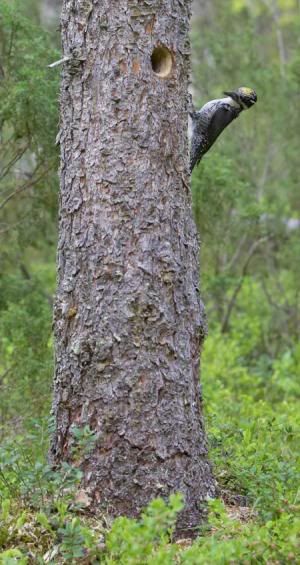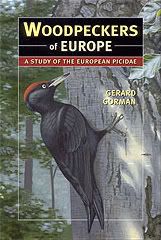 The ability that woodpeckers have of being able to excavate holes in trees is the one thing that really sets them apart from other birds. In Europe woodpeckers are primary hole-excavators, that is, they are the bird family that contributes most to the process of cavity making in forests. To be it simply THEY excavate their own holes, for breeding in and roosting in. The fact that woodpeckers can do this is one of the main reasons why they are successful. There are many advantages for both parents and chicks in being able to raise and be raised in the weatherproof haven of a chamber inside a tree. Being able to roost in such shelters is obviously an advantage for adults, too. This photo from Finland (Jari Peltomaki) shows a mlae Three-toed Woodpecker at the nest-hole. Note how the entrance hole is almost perfectly round. The hole is around one metre above ground level. Such a height is not unusual for this species though most other woodpecker species rarely nest this low. With experience many nest-holes (though not all) can be assigned to species without the bird beeing seen. When searching for woodpecker holes it should be kept in mind that it is the quality of the wood, rather than tree species, that dictates the chosen site, though some tree species are obviously preferred over others. In areas of Europe where several woodpecker species are sympatric this can mean six or even more species co-existing, and the forest riddled with various holes of differing sizes and shapes. I will discuss this further in subsequent posts.
The ability that woodpeckers have of being able to excavate holes in trees is the one thing that really sets them apart from other birds. In Europe woodpeckers are primary hole-excavators, that is, they are the bird family that contributes most to the process of cavity making in forests. To be it simply THEY excavate their own holes, for breeding in and roosting in. The fact that woodpeckers can do this is one of the main reasons why they are successful. There are many advantages for both parents and chicks in being able to raise and be raised in the weatherproof haven of a chamber inside a tree. Being able to roost in such shelters is obviously an advantage for adults, too. This photo from Finland (Jari Peltomaki) shows a mlae Three-toed Woodpecker at the nest-hole. Note how the entrance hole is almost perfectly round. The hole is around one metre above ground level. Such a height is not unusual for this species though most other woodpecker species rarely nest this low. With experience many nest-holes (though not all) can be assigned to species without the bird beeing seen. When searching for woodpecker holes it should be kept in mind that it is the quality of the wood, rather than tree species, that dictates the chosen site, though some tree species are obviously preferred over others. In areas of Europe where several woodpecker species are sympatric this can mean six or even more species co-existing, and the forest riddled with various holes of differing sizes and shapes. I will discuss this further in subsequent posts.
Friday, 21 September 2007
Holes
 The ability that woodpeckers have of being able to excavate holes in trees is the one thing that really sets them apart from other birds. In Europe woodpeckers are primary hole-excavators, that is, they are the bird family that contributes most to the process of cavity making in forests. To be it simply THEY excavate their own holes, for breeding in and roosting in. The fact that woodpeckers can do this is one of the main reasons why they are successful. There are many advantages for both parents and chicks in being able to raise and be raised in the weatherproof haven of a chamber inside a tree. Being able to roost in such shelters is obviously an advantage for adults, too. This photo from Finland (Jari Peltomaki) shows a mlae Three-toed Woodpecker at the nest-hole. Note how the entrance hole is almost perfectly round. The hole is around one metre above ground level. Such a height is not unusual for this species though most other woodpecker species rarely nest this low. With experience many nest-holes (though not all) can be assigned to species without the bird beeing seen. When searching for woodpecker holes it should be kept in mind that it is the quality of the wood, rather than tree species, that dictates the chosen site, though some tree species are obviously preferred over others. In areas of Europe where several woodpecker species are sympatric this can mean six or even more species co-existing, and the forest riddled with various holes of differing sizes and shapes. I will discuss this further in subsequent posts.
The ability that woodpeckers have of being able to excavate holes in trees is the one thing that really sets them apart from other birds. In Europe woodpeckers are primary hole-excavators, that is, they are the bird family that contributes most to the process of cavity making in forests. To be it simply THEY excavate their own holes, for breeding in and roosting in. The fact that woodpeckers can do this is one of the main reasons why they are successful. There are many advantages for both parents and chicks in being able to raise and be raised in the weatherproof haven of a chamber inside a tree. Being able to roost in such shelters is obviously an advantage for adults, too. This photo from Finland (Jari Peltomaki) shows a mlae Three-toed Woodpecker at the nest-hole. Note how the entrance hole is almost perfectly round. The hole is around one metre above ground level. Such a height is not unusual for this species though most other woodpecker species rarely nest this low. With experience many nest-holes (though not all) can be assigned to species without the bird beeing seen. When searching for woodpecker holes it should be kept in mind that it is the quality of the wood, rather than tree species, that dictates the chosen site, though some tree species are obviously preferred over others. In areas of Europe where several woodpecker species are sympatric this can mean six or even more species co-existing, and the forest riddled with various holes of differing sizes and shapes. I will discuss this further in subsequent posts.
Subscribe to:
Post Comments (Atom)





No comments:
Post a Comment